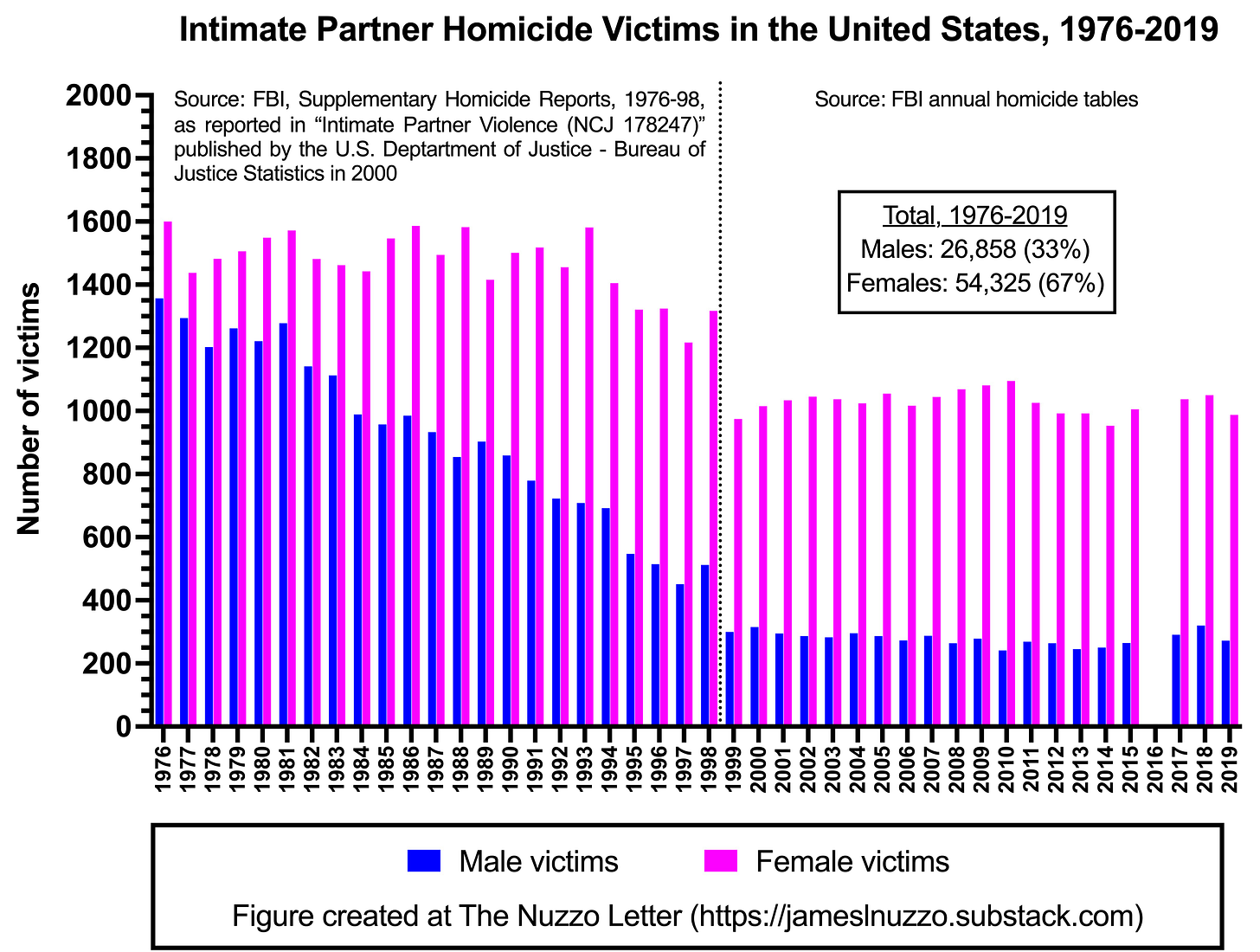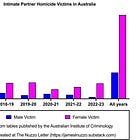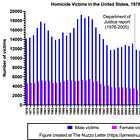This week’s graph shows the number of male and female victims of intimate partner homicide in the United States (U.S.) between 1976-2019.
Key Points
Each year between 1976-2019, more females than males were killed by their intimate partners in the U.S.
The proportion of victims who were male and female changed over time.
In the late 1970s, the number of male and female victims differed by a couple of hundred.
Throughout the 1980s and 1990s, there was a steady decline in the number of male victims, while the number of female victims remained mostly constant until the last half of the 1990s.
Since 1999, the number of male and female victims of intimate partner homicide has remained mostly constant.
Over the 44-year period from 1976 to 2019, a total of 54,325 females and 26,858 males were killed by their intimate partners. Thus, throughout this history, females were two out of every three victims of intimate partner homicide in the U.S., whereas males were one out of every three victims of intimate partner homicide in the U.S.
In the most recent years, females have been three out of every four victims of intimate partner homicide, whereas males have been one out of every four victims of intimate partner homicide.
In the graph, data from 2016 are missing because I could not find them on the FBI’s website. Thus, data from 2016 are not included in the total tally of homicides. The marked drop in number of intimate partner homicides between 1998 and 1999 is most likely due to differences in data collection and reporting methods associated with the two sources. The FBI has been criticized for publishing data that are sometimes inconsistent and difficult to decipher.
Bonus Commentary
When the concept of intimate partner violence is discussed in academia, politics, and the media, the focus is often on female victimization. A heightened level of attention on female victimization is understandable based on the fact that more females than males are killed by their intimate partners. However, completely ignoring male victimization and female perpetration – something that happens regularly at taxpayer-funded institutions like the United Nations – is not appropriate based on the data. In both the U.S. and Australia, males are about one out of every three or four victims of intimate partner homicide. In the U.S., many factors contribute to or correlate with intimate partner homicide. According to the U.S. Department of Justice’s report from 2000, rates of intimate partner homicide are highest among individuals who are divorced or separated, have a low income, are 20-24 years old, and are black.
Sources
FBI, Supplementary Homicide Reports, 1976-98, as reported in “Intimate Partner Violence (NCJ 178247)” published by the U.S. Deptartment of Justice - Bureau of Justice Statistics in 2000.
I acquired the 1999-2019 data from the FBI’s annual homicide tables. An example of one of these tables be found here. I computed the number of male victims as the sum of the number of victims of homicide perpetrated by wives and girlfriends. I computed the number of female victims as the sum of the number of victims of homicide perpetrated by husbands and boyfriends. This computation is not ideal because it assumes all relationships are heterosexual. The FBI homicide tables do not specify heterosexual versus homosexual relationships. Thus, one should not assume that “intimate partner” means “opposite sex.”
Related Content at The Nuzzo Letter
SUPPORT THE NUZZO LETTER
If you appreciated this content, please consider supporting The Nuzzo Letter with a one-time or recurring donation. Your support is greatly appreciated. It helps me to continue to work on independent research projects and fight for my evidence-based discourse. To donate, click the DonorBox logo. In two simple steps, you can donate using ApplePay, PayPal, or another service. Thank you!









Thanks for these stats Jim. I had been aware of the change over time of men being less and less the victims of intimate partner homicide. I had always assumed that the reason for this shift was that the very dangerous women were separated from the men due to domestic violence services. They were anointed victims and were given "a safe place" in the DV shelters which conveniently meant that they would not murder their spouse. If this assumption is true, which I think it is, then it seems obvious that if we want to have fewer women murdered we simply need to create the same domestic violence services for males who are victims of dv. The chart actually shows the increasing DV services for women over time as the murders of men decrease.
Men are physically stronger, so they can avoid harm.
Social awareness of female red flags in relationships (red pill et al. "movements").
I wonder how many stopped reporting due to being arrested or having no prosecutions/action.
Nevertheless, it is a great post and a solid set of stats 🔥💙